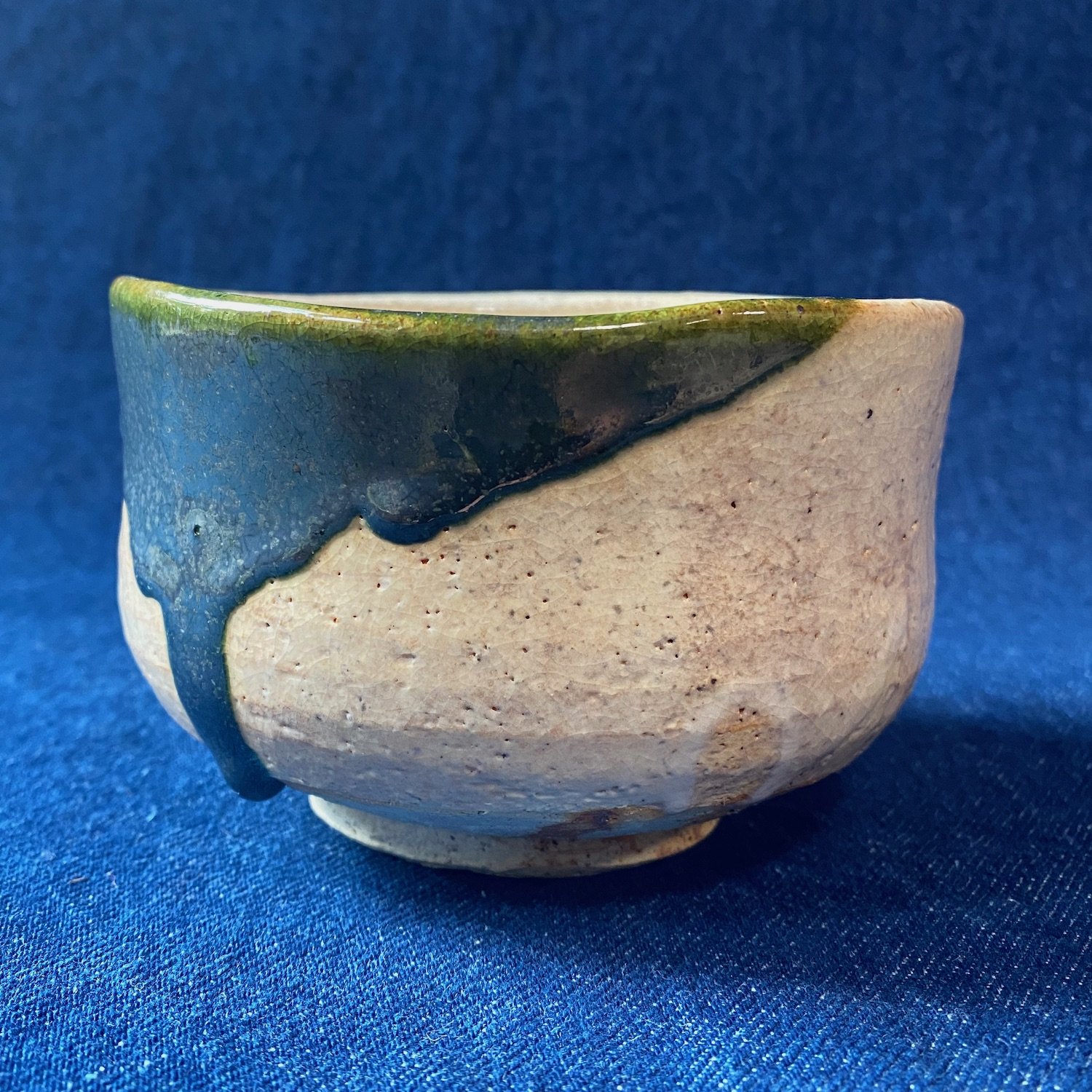 Image 1 of 5
Image 1 of 5

 Image 2 of 5
Image 2 of 5

 Image 3 of 5
Image 3 of 5

 Image 4 of 5
Image 4 of 5

 Image 5 of 5
Image 5 of 5






Oribe Chawan
Rustic matcha bowl (chawan) in the Oribe style. Oribe ware (Oribe-yaki 織部焼 ) is a style of Japanese pottery dating back to the sixteenth century, mostly made in the area of Mino, Gifu Prefecture. It is generally characterized by eccentric, asymmetrical, forms, with green copper-based glazes predominating. This chawan (age unknown) is signed “Gyokuho.”
There are two basic kinds of Japanese tea-serving cups, the yunomi (湯呑み) and the chawan (茶碗). Yunomi are made for every-day use, and have a simple, cylindrical form, usually a bit taller than wide. The chawan (literally "tea bowl"), is wider and more voluminous than the yunomi, and is designed for ceremonial use. A bamboo whisk (chasen) is used to gently mix green tea powder (matcha) into hot water in the chawan, which is then passed between the guests (that’s the short version). Though the tea bowl probably originated in China, it found its expressive potential in Japan. For example, as the wabi style came to dominate the tea ceremony during the Muromachi period (1336–1573), Korean rice-bowls (Ido chawan) became all the rage, admired for their rustic simplicity. Today, there are literally dozens of styles of chawan, from peach-shape (momo-gata) to the oblong horse bucket (badarai).
4.5” x 3”
Rustic matcha bowl (chawan) in the Oribe style. Oribe ware (Oribe-yaki 織部焼 ) is a style of Japanese pottery dating back to the sixteenth century, mostly made in the area of Mino, Gifu Prefecture. It is generally characterized by eccentric, asymmetrical, forms, with green copper-based glazes predominating. This chawan (age unknown) is signed “Gyokuho.”
There are two basic kinds of Japanese tea-serving cups, the yunomi (湯呑み) and the chawan (茶碗). Yunomi are made for every-day use, and have a simple, cylindrical form, usually a bit taller than wide. The chawan (literally "tea bowl"), is wider and more voluminous than the yunomi, and is designed for ceremonial use. A bamboo whisk (chasen) is used to gently mix green tea powder (matcha) into hot water in the chawan, which is then passed between the guests (that’s the short version). Though the tea bowl probably originated in China, it found its expressive potential in Japan. For example, as the wabi style came to dominate the tea ceremony during the Muromachi period (1336–1573), Korean rice-bowls (Ido chawan) became all the rage, admired for their rustic simplicity. Today, there are literally dozens of styles of chawan, from peach-shape (momo-gata) to the oblong horse bucket (badarai).
4.5” x 3”
Rustic matcha bowl (chawan) in the Oribe style. Oribe ware (Oribe-yaki 織部焼 ) is a style of Japanese pottery dating back to the sixteenth century, mostly made in the area of Mino, Gifu Prefecture. It is generally characterized by eccentric, asymmetrical, forms, with green copper-based glazes predominating. This chawan (age unknown) is signed “Gyokuho.”
There are two basic kinds of Japanese tea-serving cups, the yunomi (湯呑み) and the chawan (茶碗). Yunomi are made for every-day use, and have a simple, cylindrical form, usually a bit taller than wide. The chawan (literally "tea bowl"), is wider and more voluminous than the yunomi, and is designed for ceremonial use. A bamboo whisk (chasen) is used to gently mix green tea powder (matcha) into hot water in the chawan, which is then passed between the guests (that’s the short version). Though the tea bowl probably originated in China, it found its expressive potential in Japan. For example, as the wabi style came to dominate the tea ceremony during the Muromachi period (1336–1573), Korean rice-bowls (Ido chawan) became all the rage, admired for their rustic simplicity. Today, there are literally dozens of styles of chawan, from peach-shape (momo-gata) to the oblong horse bucket (badarai).
4.5” x 3”